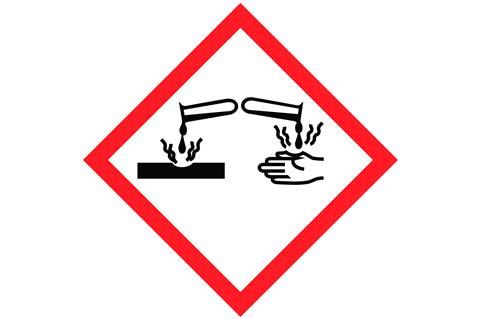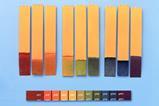11–14 chemistry: ways to introduce new secondary students to good lab routines and selecting the right apparatus
Johnny is a chemist’s son
But Johnny is no more
What Johnny thought was H2O
Was H2SO4Tourniquet, Acid head, 1994
An amusing ditty, but with an important message: colourless liquids may not be as benign as they first appear.
Chemistry is a logistically demanding subject to teach. Practical work brings together a range of hazards that multiply with class size. Teaching younger students about apparatus, hazards and safety is important to ensure classes run safely and smoothly. These topics become an important aspect of exams as students progress.
Science teachers commonly introduce new secondary school students to the laboratory in their first few weeks of lessons. Structuring learning in this area, both at the point of transition from primary school and through the early years of chemistry education, will pay dividends in the long term.

What do students need to know?
- Hazards in chemistry can be categorised into three main areas: chemical; apparatus; and human.
- The hazards associated with chemicals are classified according to the UN Globally Harmonised System (GHS) and are communicated using nine pictograms.
- Minimise apparatus hazards by choosing the right apparatus for a task and taking appropriate precautions.
- Human hazards are the most significant and unpredictable, generally causing more accidents and injuries.
- You must take precautions when carrying out experiments. Some of these are good laboratory practice, while others are specific to the procedures and chemicals used.
- Apparatus in chemistry has specific, technical names.
- Apparatus is usually represented using cross-sectional diagrams (bit.ly/2KDwOur).
- Experiment diagrams should show an arrangement of apparatus that will work in the real world for that experiment.
- Choice of apparatus for measurements should take into account the required precision and apparatus error.
- Hazards in chemistry can be categorised into three main areas: chemical; apparatus; and human.
- The hazards associated with chemicals are classified according to the UN Globally Harmonised System (GHS) and are communicated using nine pictograms.
- Minimise apparatus hazards by choosing the right apparatus for a task and taking appropriate precautions.
- Human hazards are the most significant and unpredictable, generally causing more accidents and injuries.
- You must take precautions when carrying out experiments. Some of these are good laboratory practice, while others are specific to the procedures and chemicals used.
- Apparatus in chemistry has specific, technical names.
- Apparatus is usually represented using cross-sectional diagrams (£).
- Experiment diagrams should show an arrangement of apparatus that will work in the real world for that experiment.
- Choice of apparatus for measurements should take into account the required precision and apparatus error.
Ideas for the classroom
Some aspects of hazards, safety and apparatus will need direct instruction before students even pick up a test tube. However teaching these topics should also go hand in hand with regular, good quality practical work.
Consider a unit for younger students that helps them understand the special rules that apply in science labs. They are likely to have been in their normal classroom for most of their primary science. The unit might include explicit teaching and assessment of apparatus knowledge. Students’ confidence will increase as they practise naming and using the tools of the lab. Class sets of flashcards make useful starters and plenaries as well as revision activities: bit.ly/2rYlQYJ. You could issue a ‘safety certificate’ when students prove they can carry out some commonly used procedures safely. (There is an example on page 12 of the CLEAPSS student safety sheets: bit.ly/1PxLLc9 [pdf]).
Consider a unit for younger students that helps them understand the special rules that apply in science labs. They are likely to have been in their normal classroom for most of their primary science. The unit might include explicit teaching and assessment of apparatus knowledge. Students’ confidence will increase as they practise naming and using the tools of the lab. Class sets of flashcards make useful starters and plenaries as well as revision activities. You could issue a ‘safety certificate’ when students prove they can carry out some commonly used procedures safely. (There is an example on page 12 of the CLEAPSS student safety sheet (pdf)). You can help students make sensible choices about which equipment to use with the ‘In the classroom’ activity.
You can gamify learning about hazards and apparatus using interactive quizzes. There are three apparatus Gridlocks games: rsc.li/2wZgZw7. These encourage logical thinking and improve familiarity with apparatus names and diagrams. For those who need an offline version, there are also worksheets: rsc.li/2kcPW7y [pdf].
You can gamify learning about hazards and apparatus using interactive quizzes. There are three apparatus Gridlocks games. These encourage logical thinking and improve familiarity with apparatus names and diagrams. For those who need an offline version, there are also worksheets [pdf].
Set laboratory routines
Good routines help take the fear out of managing the laboratory environment, and ensure there is maximum opportunity for learning. When designing your lab routines, consider some key questions:
- How will students enter the room?
- What will they do with their coats/bags?
- Which equipment will you expect them to get out?
- How will the time of day affect their engagement with the task?
- Do some students require additional support to access the practical work?
- Do they know what to do in the event of an accident or spill?
- How will they pack away following the practical work?
- What are the arrangements for washing up apparatus?
- When are they allowed to take off their goggles?
Assessing classroom risks
Risk assessment isn’t about filling in endless forms, nor should it stop you carrying out useful practical work. It is a process of thinking through what you plan to do, and finding ways to minimise the risks of harm. Your department should have written risk assessments for routine experiments. These should be reviewed regularly and especially when there are changes to legislation. Just as important are the on-going risk assessments you carry out during your lessons. You will know if an experiment is not appropriate for a particular class, at a particular time of day, or even given the weather outside. Comprehensive guidance on risk assessment is available from CLEAPSS and SSERC: bit.ly/2LdOuOh and bit.ly/2IEZenq. Additionally, CLEAPSS produce a ‘myth-busters’ document on procedures sometimes thought to be banned: https://rsc.li/3PoPX78.
Risk assessment isn’t about filling in endless forms, nor should it stop you carrying out useful practical work. It is a process of thinking through what you plan to do, and finding ways to minimise the risks of harm. Your department should have written risk assessments for routine experiments. These should be reviewed regularly and especially when there are changes to legislation. Just as important are the on-going risk assessments you carry out during your lessons. You will know if an experiment is not appropriate for a particular class, at a particular time of day, or even given the weather outside. Comprehensive guidance on risk assessment is available from CLEAPSS (£) and SSERC. Additionally, CLEAPSS produce a ‘myth-busters’ document on procedures sometimes thought to be banned.
Invest some time assessing if you can make the standard practical work carried out in your school safer with some easy changes. Could you switch the volumes of solution usually used in test tubes for smaller volumes and alternative containers, eg spotting tiles? Or, could you complete the whole experiment on a microscale (bit.ly/2JAQrni)? If you make this change, involve students in the process. Show them the standard scale alternatives and get them to suggest reasons why the small scale is better.
Invest some time assessing if you can make the standard practical work carried out in your school safer with some easy changes. Could you switch the volumes of solution usually used in test tubes for smaller volumes and alternative containers, eg spotting tiles? Or, could you complete the whole experiment on a microscale? If you make this change, involve students in the process. Show them the standard scale alternatives and get them to suggest reasons why the small scale is better.
Heating equipment is a common cause of small accidents and can present an additional challenge to behaviour management. Bunsen burners are rarely essential beyond some very specific examples. Often all they are needed for is a water bath. Cheap kettles in each lab make water baths much safer.
Common problems
Safety, hazards and apparatus topics are generally front-loaded into schemes of work. Students tend to associate these topics with only the practical side of their work. Some may be imprecise with language and sloppy with drawing if they fail to associate the topic with the written, assessed aspects of their chemistry course. Include well-planned questions about hazards, safety and apparatus into routine tests to reinforce the importance of these topics. For the youngest students this can be simply learning the hazard symbols and apparatus diagrams. For older students, these questions can be contextualised into other curriculum topics.
Formative assessment
These topics are not conceptually difficult. However, regular formative assessment will help students develop the accurate vocabulary and skills they need. To check students’ mastery of the topic, ask students to:
- sort cards to match apparatus pictures, diagrams and names (with appropriate distractors to highlight potential pitfalls);
- discuss their choice of apparatus for a certain purpose in routine practical work;
- collect the correct equipment from labelled drawers or trays;
- design simple experiments taking into account aspects such as scale and chemical hazards;
- draw or label apparatus diagrams during routine work;
- complete short starter and plenary activities, especially those which place the topic in context;
- make safety posters.
Progression to 14–16
Safety and apparatus in chemistry become more contextualised as students progress through their education. These topics become woven into questions about practical procedures where decisions about apparatus are much more specific. Student responses to questions about practical procedures will need to move beyond the general precaution of wearing safety goggles. They will need to be able to match their precautions to the specific hazards in the procedure being undertaken. Students will need to consider not only the appropriate type of equipment but also its scale and precision.
Help students to select the best apparatus by getting them to think about the specific purpose of the apparatus.
Download the student worksheet, ‘Why are there so many pieces of equipment for measuring volume?’ (MS Word or pdf), which introduces this topic using an enquiry-based approach, and the teacher notes (MS Word or pdf).
Alternatively, download the more challenging version of this worksheet (MS Word or pdf) for higher achieving or older students that also asks them to calculate percentage differences between measured and true values and mass from volume and density.
Take-home points
- Teaching hazards and apparatus goes alongside regular practical work and is a vital part of students’ progression to later topics.
- As this topic has links with most other topics, short tasks on apparatus and hazards make useful lesson starter and plenary activities.
- Regular discussion of hazards, safety and apparatus will help students deal with detailed consideration found in practically-focused questions in later examinations.
Downloads
Measuring volumes: pupil worksheet 11-14
Word, Size 54.08 kbMeasuring volumes: pupil worksheet 11-14
PDF, Size 50.71 kbMeasuring volumes: teacher notes
Word, Size 57.04 kbMeasuring volumes: teacher notes
PDF, Size 50.5 kbMeasuring volumes: pupil worksheet 14-16 / extension
Word, Size 58.5 kbMeasuring volumes: pupil worksheet 14-16 / extension
PDF, Size 56.08 kb
















No comments yet